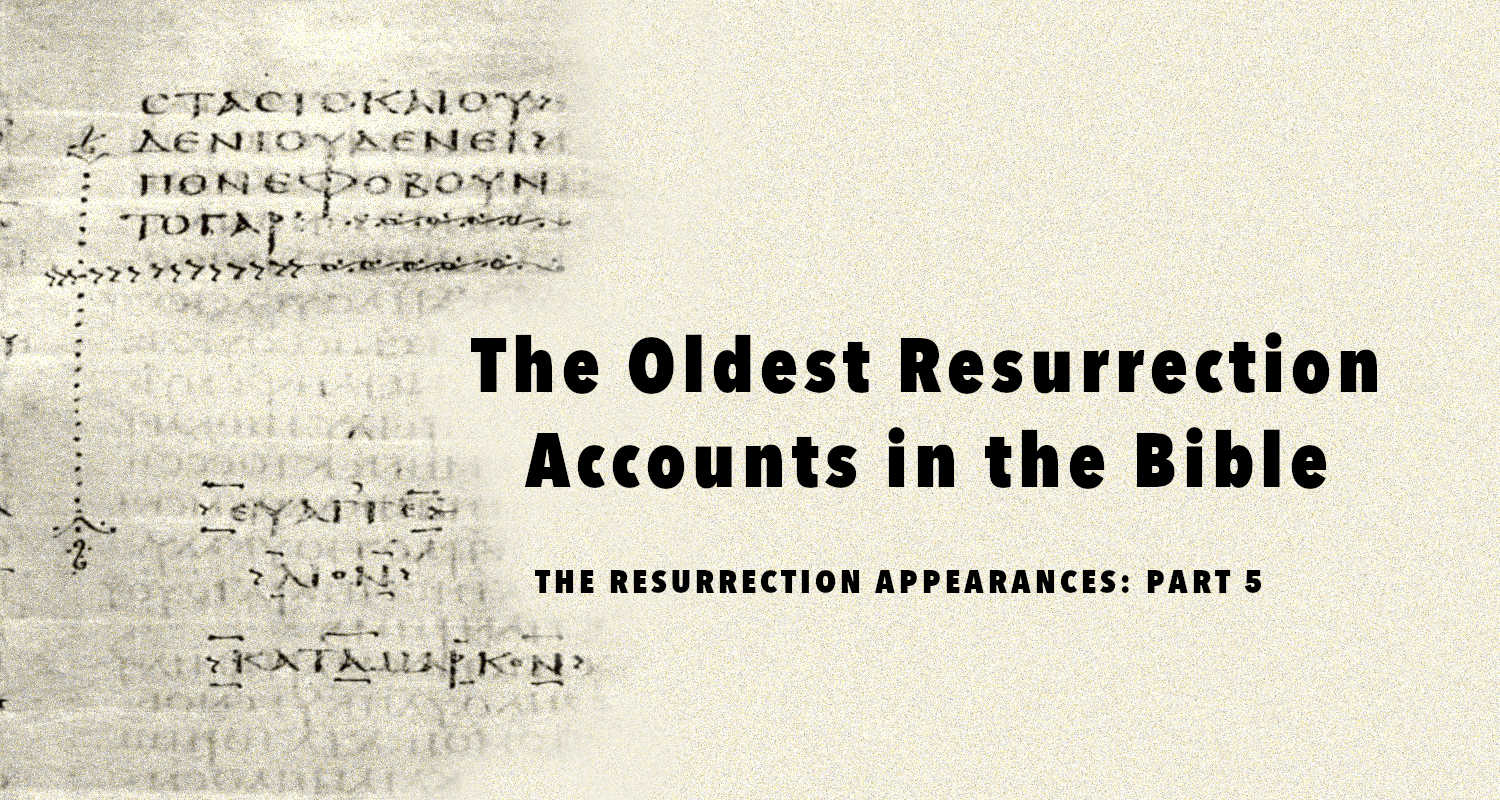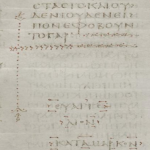
The New Testament witnesses to numerous resurrection appearances of the risen Jesus during the evangelium quadraginta dierum ("the gospel of forty days" as Karl Barth called it) between the Empty Tomb and the Ascension. But which scripture is the oldest account and original form of them all? Many of the resurrection appearances (such as in the Gospel of John) were written many decades (or a century or more) after the death of Jesus Christ. Which resurrection appearance in the New Testament represents the oldest form of the resurrection appearances accounts in the Bible? Are they all the equally credible witnesses, or has there been significant accretions to the original eye-witness reports that must be demythologized?
The oldest Gospel has no resurrection appearances
Mark is the oldest gospel but it does not contain any resurrection appearances, and all of the resurrection appearances in the other gospels were written after Mark. So some scholars conclude that the resurrection appearances tradition is foreign to the earliest form of Christianity, and it is an accretion that began at the end of the first century. Also, Matthew and Luke do not have substantial agreement in their common resurrection appearances material indicating that the Q logia did not have a passion account or resurrection appearances either. The alternate endings to Mark were added later to address this problematic silence regarding the resurrection of Jesus, and even very conservative bibles place these longer endings in brackets. At first glance, Mark suggests that the resurrection of Jesus is a myth of a later age.
 It is a well known fact that Mark has a truncated ending with the last words "for they were afraid" and the very last word is gar ("for"); this suspicious and unnatural grammatical ending indicates that either Mark is unfinished or its endings are lost (e.g. maybe the end of the scroll was damaged). (I've included an image of the ending of the Gospel of Mark from the codex sinaiticus on the right.) And there's substantial agreement among scholars that Mark is an incomplete fragment, and therefore it is an argumentum e silentio that Mark is unaware of the resurrection or that the resurrection appearances were fabricated after Mark. The alternate endings of Mark (i.e. Mark 16:9ff, etc.) in conjunction with resurrection appearances in Matthew and Luke suggest that the older tradition had resurrection appearances, and these later gospels were written to communicate what was already commonly preached in the decades before the first gospel (Mark) was written.
It is a well known fact that Mark has a truncated ending with the last words "for they were afraid" and the very last word is gar ("for"); this suspicious and unnatural grammatical ending indicates that either Mark is unfinished or its endings are lost (e.g. maybe the end of the scroll was damaged). (I've included an image of the ending of the Gospel of Mark from the codex sinaiticus on the right.) And there's substantial agreement among scholars that Mark is an incomplete fragment, and therefore it is an argumentum e silentio that Mark is unaware of the resurrection or that the resurrection appearances were fabricated after Mark. The alternate endings of Mark (i.e. Mark 16:9ff, etc.) in conjunction with resurrection appearances in Matthew and Luke suggest that the older tradition had resurrection appearances, and these later gospels were written to communicate what was already commonly preached in the decades before the first gospel (Mark) was written.
Wolfhart Pannenberg argues that the Apostolic Preaching (kerygma) always includes the same basic points, which includes the announcement that Jesus Christ has risen from the dead (c.f. C. H. Dodd's Apostolic Preachings and Its Developments), and the preaching of the apostles in Acts is in agreement with the kerygma in Paul's letters. Therefore, pace Pannenberg, the resurrection appearances in Matthew and Luke are modified forms of an older tradition that predates Mark. Furthermore, the resurrection appearances in Paul's letters are virtually universally accepted to be older than Mark, and their consistency strengthen Pannenberg's argument.
Pannenberg says, "Though Schillebeeckx still emphasizes the close connection between the resurrection and Easter appearances, his reconstruction fails to do justice to the basic significance of the appearances of the risen Lord in both Paul and the gospel accounts. His thesis sees to rest on the source reconstructed from Luke and Matthew and his inferring from the lack of any appearances in this source that the tradition behind it knew of no appearances. But this argument from silence is not a very sure basis for an understanding of the rise of Easter faith that runs totally counter to the Gospels as well as Paul. We must begin with the fact that the Easter appearances formed the starting point for the kergyma [apostolic preaching] of the resurrection of the Crucified." [1]
Pannenberg admits that in some of the later New Testament accounts of the resurrection appearances, "we perhaps have a later stage of the tradition with legendary and in part tendentious features (Luke 24:39ff)" [2]. So the received form of the resurrection appearances in Matthew and Luke testify to an older form but they have been redacted from the pure original form. Pannenberg says the "details have possibly been reshaped, yet a factual core may still underline the narratives." [3] And so the more fantastic features of the later resurrection appearances (such as Matthew 27:52-53) may be accretions from a later time.
The resurrection appearances in Paul's letters
Pannenberg argues "the oldest form of the appearances tradition" is in 1 Cor 15:3-7 because Paul "knew personally the witnesses cited, or most of them, being himself the last in the series (1 Cor 15:8)" and he referenced them because they were already well known throughout the churches in the world. Pannenberg argues that Paul's resurrection appearances were not fabricated by Paul, but they were cited "in order to support his argument in the epistle" (1 cor 15:4). This means that Paul appealed to a much older tradition of resurrection appearances to give himself credibility among the churches to whom his letters were addressed.
Pannenberg says the "Jerusalem disciples seem to have recognized the apostolic commissioning of Paul by the Lord himself in accordance with Paul's own resolute appeal (Gal 1:1,12) and on the basis of the appearance of the risen Lord to him (cf. Gal 2:9). This means that they found sufficient agreement between his experience and the meetings of the original disciples of the Lord. In opposition it might be pointed out that Luke does not seem to have given the same ranking to the appearance of Paul as to the appearances to the other disciples before the ascension. But Luke's sharper distinction between the time before and the time after the ascension seems perhaps to be a deviation of his own from the original equation of the resurrection and ascension. [4]
The Resurrection Appearances series:
- The Resurrection Appearances: 1. The Argument for Historical Facticity
- The Resurrection Appearances: 2. Eyewitnesses, Visions or Hallucinations?
- The Resurrection Appearances: 3. Faith in the Empty Tomb is an Empty Faith
- The Resurrection Appearances: 4. The Third Day: A Theological Symbol or a Historical Date and Time?
- The Resurrection Appearances: The Oldest Resurrection Accounts in the New Testament (Part 5)
- Coming soon . . .
Sources:
1. Pannenberg, Wolfhart. Systematic Theology (Volume 2). trans. Geoffrey W. Bromiley, Wm. B. Eerdmans Publishing Co., 2001. Print. 356.
2. Ibid. 354-5.
3. Ibid. 354.
4. Ibid. 353.



April 20th, 2019 - 15:15
Mark without a resurrection narrative? In Mark, Jesus’ predicts his resurrection at several points. Further, Irenaeus, writing more than a century before Sinaiticus and Vaticanus, knows the longer ending of Mark. Also, I am not so sure that Mark is not a quick, down and dirty abridgment of Matthew.
April 25th, 2019 - 23:32
I really doubt that the so called longer ending Mark wouldn’t contain a resurrection narrative, since, like Kepha said, Jesus predicted His resurrection at various points in Mark. Also, the young man clearly said that Jesus was risen.
I think that the theory of Wright, that since Matthew up that point is very similar with Mark, probable the long ending would be similar